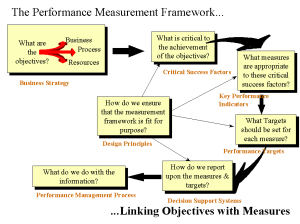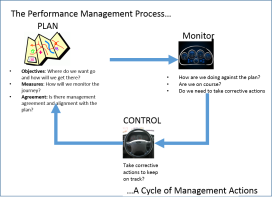 ‘If you can’t measure it, you can’t manage it’ is a refrain that managers often hear but do not fully appreciate until confronted with a major challenge such as the complexity of a business transformation programme. The need to diagnose the problems, stop the rot and prescribe timely and effective treatment, often quickly overwhelms management that is more used to reactive management of day to day events.
‘If you can’t measure it, you can’t manage it’ is a refrain that managers often hear but do not fully appreciate until confronted with a major challenge such as the complexity of a business transformation programme. The need to diagnose the problems, stop the rot and prescribe timely and effective treatment, often quickly overwhelms management that is more used to reactive management of day to day events.
Driving through the strategy should be the focus of all management. Performance management enables managers to maximise and sustain corporate performance by measuring and managing the drivers of future profitability. Those drivers are what a business should invest in now to sustain and improve performance. The start point must be to quickly establish the necessary disciplines and approaches for the design and implementation of an effective management information system. Such systems must comprise not only the key performance indicators (KPI’s), but also the execution management skills and processes to use them effectively in achieving operational and strategic objectives.
Silo’d Confusion
An organisation’s efforts to develop effective management information systems are often hampered by confusion caused by factors that include a one-dimensional, simplistic view of the problems. For example:
- The finance view – ‘All we need to do is supplement our financial information with a range of non‑financial measures.’
- The IT view – ‘All we need is a data warehouse and interrogation software to exploit the operational data.’
- The management view – ‘All we need are better managers and staff.’
- The staff view – ‘All we need is a business strategy and effective management.’
All these views may be valid, but the inter-relationships and dependencies between them are not identified and so critical thinking is impossible. The absence of a universally accepted discipline for management information, similar to that for accounting which underpins the development and integrity of financial information, means there is limitless scope for confusion and paralysis.
A disciplined and structured approach to developing a performance management system must address the execution management processes, training and personnel issues to make effective interventions and encourage appropriate behaviours.
The Performance Measurement Framework
Business managers inhabit a practical world of reacting to day to day operational issues. They may not have the time nor interest in relating the management theories and measurement concepts that underlie the design of a performance management system.
the time nor interest in relating the management theories and measurement concepts that underlie the design of a performance management system.
The Performance Measurement Framework model links business objectives to the interventions needed to manage their achievement and gives managers a key to relating the concepts with the practical steps they can immediately take to develop their own performance measures.
The framework model is structured as a sequence of provocations linking business objectives with performance measures. The performance measures feed the performance management process to actively manage the business on timely actionable intelligence. Each of the provocations is addressed by practical approaches and quality assured by the pre-determined design principles.
The design principles reflect the values and behaviours that an organisation wishes to embed in all aspects of its structure, processes and relationships.
The Performance Management Process
A performance measurement system is often described as a ‘dashboard’, similar to that of a car. Taking the analogy further, the performance management process ensures that the driver is sitting in the driving seat, knows how to drive and where he is going! As with a car, the driver must plan the route and fuel the car, monitor the journey and take control with appropriate actions to ensure a safe and timely arrival. Managers use just such a cycle to ‘drive’ through the business strategy.
The Performance Management Process is one of the tools Blue-Plate uses to support the KeyneLink Strategy Execution Management approach, and enable managers to visualise and understand the component parts of the process.
This conceptual understanding is a prerequisite to equipping managers to design and implement a performance management process that is appropriate for their organisation.
Very useful post about measuring performance and the dangers of silos, partial and disconnected approaches.